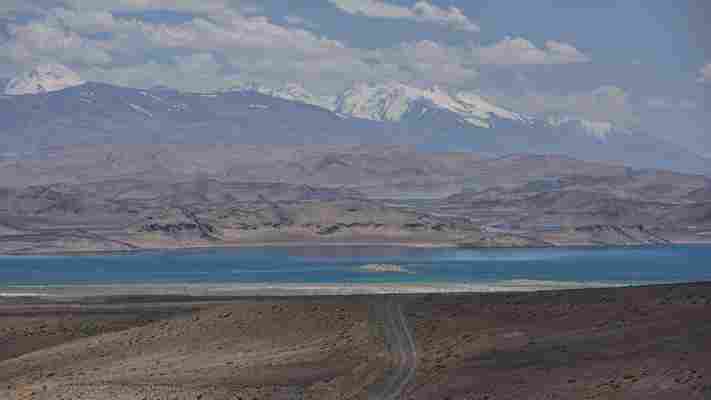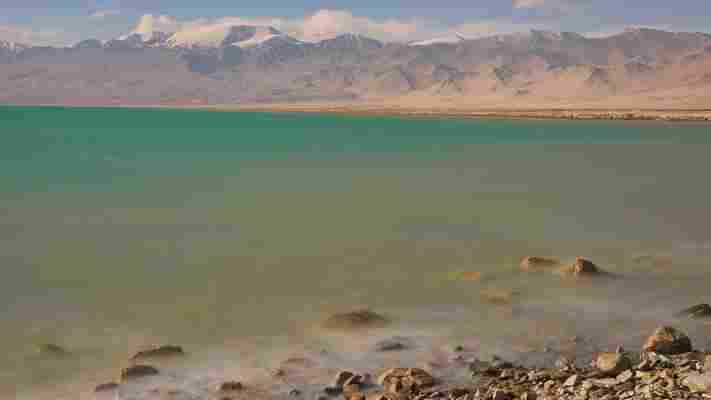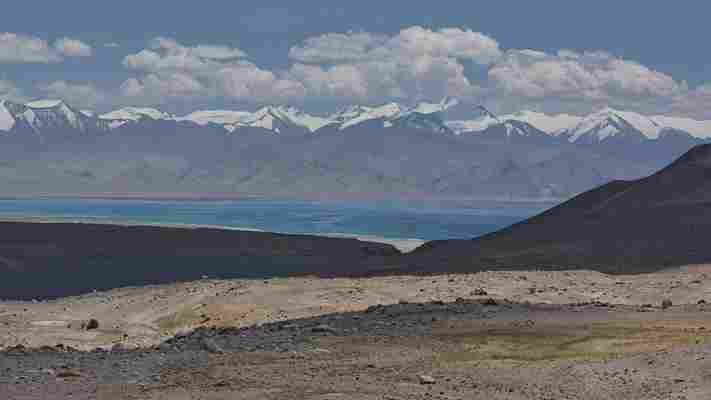

Lake Karakul in Tajikistan is even higher than South America’s fabled Lake Titicaca
Perched at an elevation of about 4,000m in the midst of the High Pamir mountains of Tajikistan, Lake Karakul is even higher than South America’s fabled Lake Titicaca. The immense body of water – some 380 sq km in area and up to 230m deep – was formed by a meteorite that struck the Earth some 25 million years ago, and sits inside an impact crater. Stunningly beautiful, Karakul is surrounded by snowy mountains and high desert moonscape, and can be reached via the Pamir Highway ([one of the world’s most epic road trips](http://www.bbc.com/travel/story/20190102-pamir-highway-a-wild-ride-across-central-asia)). (Credit: Dave Stamboulis)

Lake Karakul changes colour throughout the day
Christened Lake Victoria by British cartographers, and later changed to ‘Kara Kul’ or ‘Black Lake’ by the Soviets, the lake actually changes colour throughout the day, from various shades of turquoise and emerald to deep cobalt blue. It is a top attraction for intrepid travellers making their way across Central Asia; the nearest towns are Murghab in Tajikistan or Osh across the border in Kyrgyzstan. (Credit: Dave Stamboulis)
Lake Karakul is one of the most saline lakes in Asia
Ringed by salt deposits, the lake has no outflow and is one of the most saline in Asia. In fact, its salt content is so dense that it is devoid of marine life other than the stone loach, a freshwater fish that can live on sandy-bottom lakes. However, the marshy wetlands and islands found in the lake do attract a vast array of migratory birds such as Himalayan vultures and Tibetan sandgrouse. Additionally, Karakul is so salty, it’s very difficult to navigate a boat on it without capsizing due to the vessel riding so far out of the water. (Credit: Dave Stamboulis)
Karakul is almost a Central Asian version of the Middle East’s hyper-saline Dead Sea
Karakul is almost a Central Asian version of the Middle East’s hyper-saline Dead Sea, although that hasn’t stopped visitors from trying to sail here. The lake is now home to the aptly named annual [Roof of the World Regatta](https://www.facebook.com/roofoftheworldregatta/), which brings enthusiasts from around the world for a quirky festival each summer that includes wakeboarding, kitesurfing and inflatable rafting. (Credit: Dave Stamboulis)
The Lake Karakul area was used as a camp for German prisoners of war during World War Two
The lake area was used as a prison camp for German prisoners of war during World War Two, and later became a prime grazing spot for Kyrgyz nomads who brought their sheep and goats up from lower pastures during the summer. These days, however, the only local inhabitants – who live on the lake’s far eastern side in a small village also known as Karakul – are a few hardy Kyrgyz who operate homestays for the adventuresome visitors who brave the rigours of the Pamir Highway to get here. (Credit: Dave Stamboulis)
The village near Lake Karakul is reminiscent of a Greek island
Walking around the village in the surreal morning light, the whitewashed and pastel-blue homes resemble something out of a Greek island. Yet the entire place feels like a ghost town, with few inhabitants out due to both the baking hot sun during the summer months and brutally cold high-altitude temperatures that freeze the town and lake the rest of the year. Additionally, despite the high salinity of Karakul, the lake and village are plagued by mosquitoes throughout the warm season. (Credit: Dave Stamboulis)
The Lake Karakul region was along one of the ancient Silk Road routes
Walking through the deserted streets, there are reminders that this place was once an inhabited Central Asian crossroads. It was one of the ancient Silk Road routes, and, as one of the few settlements in a remote and extreme mountain terrain, a caravan stop between Kashgar in China and Bukhara and Samarkand in Uzbekistan. An old whitewashed mosque sits in silence, and mud-brick adobe homes offer refuge and utilise local building materials to survive the elements. It’s an eerie spot, made even more surreal by the flat and low-lying buildings dwarfed by open sky and endless space. (Credit: Dave Stamboulis)
Lake Karakul is one of the driest places in all Central Asia
The endless mountain ranges surrounding the lake ensure that humid air masses don’t reach here, and with less than 30mm of rainfall per annum, it is one of the driest places in all Central Asia. The inhabitants might be few and the ghostly lake hard to reach, but its recent status as part of the [Tajik National Park](http://www.nhpfund.org/sng/tajik-np.html) ensures that it will be on the intrepid travel list of many for years to come. (Credit: Dave Stamboulis)
Leave a Comment